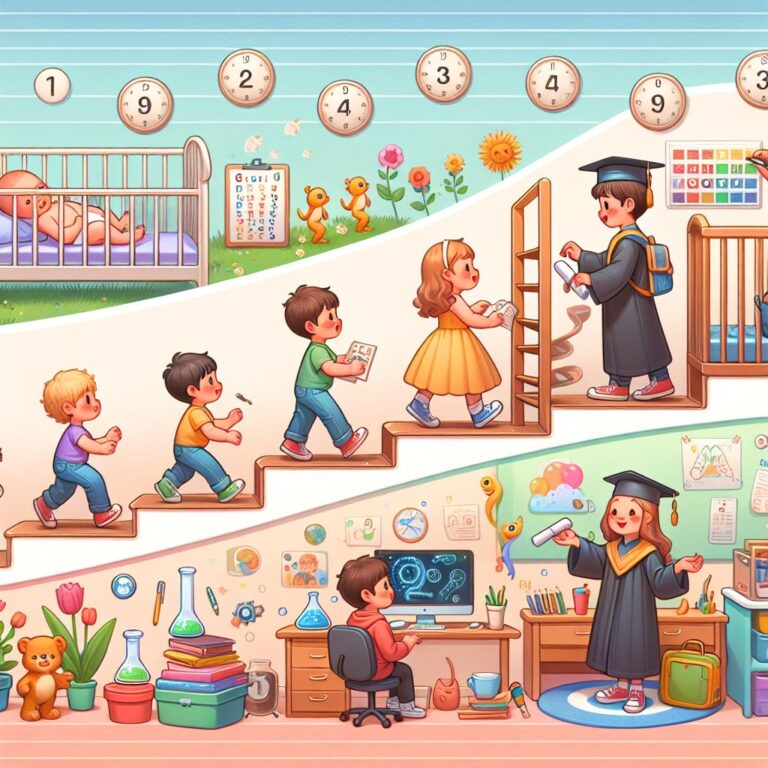Key Takeaways
- Setting educational goals helps children develop responsibility and perseverance, key traits for lifelong success.
- Encouraging a love for learning can be achieved by aligning goals with children’s interests and making learning fun.
- Building a strong foundation in core subjects like math, language, and science is crucial for overall educational development.
- Critical thinking and problem-solving skills can be enhanced through logical reasoning exercises and strategy games.
- Cultivating creativity involves engaging in art exploration and imaginative play, fostering innovation in children.
Importance of Setting Educational Goals
Setting educational goals for kids is a powerful way to inspire growth and development. It gives them a sense of direction and purpose, making learning more meaningful. By establishing clear objectives, children learn to plan, prioritize, and take responsibility for their actions. This process not only enhances their academic performance but also builds their confidence and resilience.
When children set goals, they become active participants in their learning journey. They are more likely to stay motivated and engaged, as they can see the progress they are making towards their objectives. This sense of accomplishment fuels their desire to learn and achieve even more.
Encouraging a Love for Learning
Fostering a love for learning is essential for long-term educational success. When children enjoy the process of acquiring knowledge, they are more likely to pursue it with enthusiasm and curiosity. One effective way to encourage this passion is by aligning educational goals with their interests.
For instance, if a child loves animals, incorporating animal-related topics into their science or reading goals can make learning more enjoyable. Besides that, creating a positive learning environment at home, where curiosity is encouraged and mistakes are seen as opportunities to learn, can significantly impact a child’s attitude towards education.
Building a Strong Foundation in Core Subjects
A strong foundation in core subjects is vital for children’s overall educational growth. These subjects provide the basic skills and knowledge needed for more advanced learning. Focusing on math, language, and science ensures that children develop essential competencies that will benefit them throughout their academic journey.
Math Proficiency
Math is a critical subject that plays a significant role in everyday life. Developing proficiency in math not only enhances problem-solving skills but also boosts logical thinking. To build a solid math foundation, children should focus on understanding fundamental concepts, such as addition, subtraction, multiplication, and division.
Engaging children in real-world math problems can make the subject more relatable and exciting. For example, involve them in cooking to practice measurements and fractions, or use shopping trips to teach them about budgeting and calculating discounts.
Language Skills
Language skills are crucial for effective communication and comprehension. Encouraging children to read regularly can significantly improve their vocabulary, grammar, and writing abilities. Reading diverse materials, such as books, magazines, and online articles, exposes them to different writing styles and perspectives.
Besides reading, engaging in conversations with children and encouraging them to express their thoughts and ideas can enhance their verbal skills. Encourage them to write stories or keep a journal to practice their writing in a fun and creative way. For more ideas, explore these winter reading activities to keep kids engaged indoors.
Science Exploration
Science exploration fuels curiosity and a desire to understand the world. Encouraging children to ask questions and seek answers through experiments and observations can make science a thrilling adventure. Simple experiments at home, like growing plants or observing the weather, can ignite a passion for scientific inquiry.
Furthermore, visiting science museums or participating in science clubs can provide hands-on experiences that enhance their understanding and interest in the subject.
Promoting Critical Thinking and Problem-Solving Skills
Critical thinking and problem-solving are essential skills for navigating complex challenges in life. Developing these skills involves encouraging children to analyze situations, think logically, and make informed decisions. Providing opportunities for them to solve problems independently fosters confidence and self-reliance.
One effective way to promote these skills is through activities that require strategic thinking and planning. For example, puzzle-solving and playing strategy games like chess can help children develop logical reasoning and problem-solving abilities.
Encouraging Imaginative Play
Imaginative play is a crucial aspect of childhood development. It allows children to explore different roles, scenarios, and ideas in a safe and creative environment. Through imaginative play, children develop problem-solving skills, learn to negotiate and cooperate with others, and enhance their ability to express emotions.
Encouraging imaginative play can be as simple as providing a variety of toys and materials that spark creativity. For instance, building blocks, art supplies, and costumes can inspire children to create their own worlds and stories. Parents can also participate in imaginative play by joining in their child’s games, which not only strengthens the parent-child bond but also models creative thinking.
Enhancing Emotional Intelligence
Emotional intelligence is the ability to recognize, understand, and manage one’s own emotions and the emotions of others. It is a vital skill that helps children build strong relationships, navigate social situations, and cope with challenges effectively.
Recognizing and Expressing Emotions
Teaching children to recognize and express their emotions is the first step in developing emotional intelligence. Encourage children to talk about their feelings by asking open-ended questions like, “How did that make you feel?” or “What do you think caused that emotion?” This practice helps them articulate their emotions and understand the underlying causes. For more on setting goals for emotional growth, consider these educational goals for the new year.
Using tools like emotion charts or storybooks that explore different feelings can also aid in this process. Children learn to identify emotions by associating them with characters and scenarios they read about, making it easier for them to express their own feelings. For more ideas, check out these ways to get your kids excited about reading.
Empathy and Social Skills Development
Empathy is the ability to understand and share the feelings of others. It is a crucial component of emotional intelligence and plays a significant role in developing strong social skills. Teaching empathy involves encouraging children to consider other people’s perspectives and feelings. For parents, setting a good example is essential, as they serve as role models for their children.
Role-playing activities can be particularly effective in teaching empathy. By putting themselves in someone else’s shoes, children learn to appreciate different viewpoints and develop compassion. Additionally, discussing scenarios where empathy is required, such as helping a friend in need, reinforces the importance of this skill.
Strategies to Achieve Educational Goals
Setting educational goals is just the beginning. To achieve these goals, it’s essential to have effective strategies in place. These strategies involve creating a supportive environment, setting clear objectives, and utilizing available resources to maximize learning opportunities. For more insights on how to set and achieve educational goals, consider exploring additional resources.
Incorporate SMART Goals
The SMART framework is an effective method for setting and achieving educational goals. SMART stands for Specific, Measurable, Achievable, Relevant, and Time-bound. By using this framework, goals become more structured and attainable, providing children with a clear roadmap to success.
Specific Objectives
Goals should be specific and clearly defined. Instead of setting a vague goal like “do better in school,” focus on a particular area of improvement. For example, “improve math grades by practicing multiplication tables every day” is a specific and actionable goal.
Measurable Outcomes
Measuring progress is crucial for maintaining motivation and ensuring that goals are being met. Establish criteria for success, such as completing a certain number of practice problems or achieving a specific test score. This allows children to track their progress and see how far they’ve come. For more ideas on engaging activities, consider exploring winter reading activities that can keep kids motivated indoors.
Regularly reviewing and adjusting these measurable outcomes helps keep goals relevant and achievable. Celebrate small victories along the way to keep children motivated and engaged. For more ideas, check out how to encourage your child to read more in the new year.
Create a Supportive Environment at Home
A supportive home environment is essential for achieving educational goals. Parents can play a significant role by fostering a positive attitude towards learning and providing the necessary resources and encouragement. For more insights, consider exploring the importance of setting a good example as parents to inspire a love for reading in children.
Establish Learning Routines
Consistent learning routines help children develop good study habits and maintain focus. Set aside specific times for homework and study sessions, ensuring that these times are free from distractions. A designated study area with all the necessary materials can also enhance concentration and productivity. For more tips on setting educational goals, check out this guide on achieving educational goals for the new year.
- Create a quiet and organized study space.
- Set regular study times each day.
- Encourage breaks to prevent burnout.
- Use a planner to track assignments and deadlines.
By establishing these routines, children learn to manage their time effectively and develop a sense of responsibility for their learning.
Positive Reinforcement Techniques
Positive reinforcement can significantly impact a child’s motivation and attitude towards learning. Recognizing and rewarding achievements, no matter how small, encourages children to continue striving for their goals. This can be done through praise, rewards, or even a simple acknowledgment of their efforts.
Utilize Technology and Educational Tools
In today’s digital age, technology offers a wealth of resources to support children’s learning. Educational apps and online platforms can provide interactive and engaging ways to reinforce concepts and practice skills.
However, it’s important to balance screen time with other activities to ensure a well-rounded educational experience. Parents should guide their children’s use of technology, ensuring that it complements their learning goals.
Educational Apps and Games
Educational apps and games can make learning fun and interactive. They offer opportunities for practice and reinforcement in various subjects, from math and reading to science and art. Popular apps like Khan Academy, Duolingo, and Prodigy provide engaging content that aligns with educational standards.
Encourage children to explore these resources, but also ensure that they are using them effectively by setting time limits and monitoring progress. Combining technology with traditional learning methods creates a balanced approach to education.
Interactive Learning Platforms
Interactive learning platforms have revolutionized the way children learn by making education more engaging and accessible. These platforms offer a variety of resources, such as videos, quizzes, and interactive exercises, that cater to different learning styles. For instance, platforms like Khan Academy and Coursera provide comprehensive courses on a wide range of subjects, allowing children to learn at their own pace.
By integrating these platforms into their learning routine, children can access a wealth of information and practice materials that enhance their understanding and retention of concepts. Moreover, many platforms offer personalized learning experiences, adapting content to match the child’s progress and needs. For ideas on how to keep kids engaged, consider a holiday reading challenge.
Foster a Growth Mindset
Fostering a growth mindset in children is crucial for their educational and personal development. A growth mindset is the belief that abilities and intelligence can be developed through effort, learning, and perseverance. This mindset encourages children to embrace challenges, persist in the face of setbacks, and view failures as opportunities for growth.
To cultivate a growth mindset, parents and educators should praise effort rather than innate talent. For example, instead of saying, “You’re so smart,” say, “I love how hard you worked on this project.” This shift in language emphasizes the importance of effort and encourages children to take on new challenges. For more ideas on encouraging children, consider exploring how to encourage your child to read more in the new year.
Moreover, teaching children about the brain’s ability to grow and change through learning can inspire them to adopt a growth mindset. Explain that the brain is like a muscle that gets stronger with use, and that mistakes are a natural part of the learning process. For parents, understanding the importance of setting a good example can further encourage children to embrace this mindset.
Encouraging children to set goals and reflect on their progress can also reinforce a growth mindset. By regularly reviewing their achievements and identifying areas for improvement, children learn to take ownership of their learning journey and develop resilience.
Example: “After struggling with math problems, Sarah learned to view her mistakes as learning opportunities. With practice and perseverance, she improved her skills and gained confidence in her abilities.”
Encouragement and Resilience Building
Building resilience in children is essential for helping them navigate the challenges of life. Resilience is the ability to bounce back from setbacks, adapt to change, and keep going in the face of adversity. Encouragement plays a key role in fostering resilience by providing children with the support and motivation they need to persevere. For more ideas on how to encourage your child, consider setting reading resolutions to motivate them to read more in the new year.
One way to encourage resilience is by teaching children problem-solving skills. When faced with a challenge, guide them through the process of identifying the problem, brainstorming solutions, and evaluating the outcomes. This approach empowers children to tackle difficulties independently and develop a sense of competence.
Learning from Mistakes
Mistakes are valuable learning opportunities that can teach children important lessons about perseverance and growth. Instead of viewing mistakes as failures, encourage children to see them as stepping stones to success. This mindset helps children build resilience and develop a positive attitude towards learning.
To help children learn from mistakes, create a supportive environment where they feel safe to take risks and experiment. Encourage them to reflect on what went wrong and what they can do differently next time. This process fosters critical thinking and problem-solving skills.
Final Thoughts on Educational Growth
Educational growth is a continuous journey that requires dedication, effort, and the right strategies. By setting clear goals, fostering a love for learning, and building essential skills, children can achieve their full potential and thrive in their educational pursuits. For example, setting reading resolutions can be a great strategy to encourage children to read more and develop a lifelong passion for learning.
- Set realistic and achievable goals to maintain motivation.
- Create a supportive learning environment at home.
- Encourage a growth mindset and resilience in children.
- Utilize technology and educational tools to enhance learning.
- Celebrate achievements and milestones to reinforce progress.
By implementing these strategies, parents and educators can inspire children to become lifelong learners and equip them with the skills they need to succeed in an ever-changing world. For additional ideas, explore winter reading activities that keep kids engaged indoors.
Remember, the key to educational growth is consistency and perseverance. With the right mindset and support, children can overcome challenges and achieve their goals.
Continuous Review and Adaptation of Goals
Regularly reviewing and adapting educational goals is essential for ensuring that they remain relevant and achievable. As children grow and develop, their interests and abilities may change, requiring adjustments to their goals.
Encourage children to reflect on their progress and identify areas where they may need additional support or new challenges. This process helps them take ownership of their learning journey and develop a sense of responsibility for their education.
Celebrating Achievements and Milestones
Celebrating achievements and milestones is an important part of the learning process. Recognizing and rewarding progress, no matter how small, reinforces children’s efforts and motivates them to continue striving for their goals.
Whether it’s a simple word of praise, a special treat, or a family celebration, acknowledging accomplishments boosts children’s confidence and reinforces the value of hard work and perseverance.
Frequently Asked Questions (FAQ)
Parents and educators often have questions about how to best support children’s educational growth. Here are some common questions and answers to help guide you in this journey.
What are the benefits of setting educational goals for kids?
Setting educational goals provides children with a sense of direction and purpose, making learning more meaningful. Goals help children develop important skills such as planning, prioritization, and responsibility, which contribute to their overall academic and personal growth.
Moreover, achieving goals boosts children’s confidence and motivation, encouraging them to take on new challenges and continue learning. By setting and achieving goals, children learn the value of hard work and perseverance. For parents, understanding the importance of setting a good example can further enhance this learning process.
Example: “When Alex set a goal to improve his reading skills, he felt a sense of accomplishment as he progressed. This success motivated him to set new goals and continue learning.”
How do I help my child set realistic goals?
To help your child set realistic goals, start by discussing their interests and aspirations. Encourage them to choose goals that are specific, measurable, achievable, relevant, and time-bound (SMART). This framework ensures that goals are clear and attainable, providing a roadmap for success.
Work with your child to break down larger goals into smaller, manageable steps. This approach makes goals less overwhelming and allows children to track their progress and celebrate small victories along the way. For more ideas, consider creating a reading plan together as part of your family New Year’s resolutions.
What can I do to support my child’s learning journey at home?
Supporting your child’s learning journey at home involves creating a positive and supportive environment. Establish consistent learning routines, provide access to educational resources, and encourage open communication about their progress and challenges. For more ideas, consider the importance of creating a reading plan together as a family.
Additionally, be involved in your child’s learning by showing interest in their activities and providing guidance when needed. Celebrate their achievements and offer encouragement to keep them motivated and engaged.
How do I encourage my child to develop a growth mindset?
Encouraging a growth mindset involves teaching children that abilities and intelligence can be developed through effort and learning. Praise effort rather than innate talent, and emphasize the importance of perseverance and resilience. For more ideas, consider setting reading resolutions to motivate your child in the new year.
Provide opportunities for children to face challenges and learn from mistakes. Encourage them to set goals and reflect on their progress, reinforcing the idea that growth is a continuous journey.
What resources are available to help children achieve their educational goals?
There are numerous resources available to support children’s educational growth. Educational apps and online platforms offer interactive and engaging content that aligns with educational standards. Libraries, museums, and community programs also provide valuable learning opportunities.
Additionally, parents and educators can seek guidance from educational professionals, such as teachers and tutors, to ensure that children receive the support they need to achieve their goals.
By utilizing these resources and strategies, children can develop the skills and knowledge they need to succeed in their educational pursuits and beyond.
As the new year approaches, many parents are considering ways to enhance their children’s educational experience. Setting goals for reading can be a great way to start. Encouraging children to read more not only improves their literacy skills but also broadens their understanding of the world. For tips on how to make this a successful endeavor, check out our guide on setting reading resolutions for your child.






